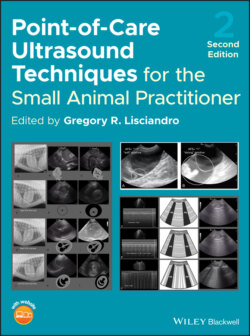Читать книгу Point-of-Care Ultrasound Techniques for the Small Animal Practitioner - Группа авторов - Страница 226
Use of the AFAST AFS System as an Exit Exam Postintervention
ОглавлениеPhysical examination, laboratory testing, and radiography are insensitive and unreliable tests for the presence of free fluid in small animals (Rozycki 1998; Rozycki et al. 1998, 2001; Boysen et al. 2004; Lisciandro et al. 2009; Lisciandro 2012; Boysen and Lisciandro 2013; McMurray 2016), and there is no reason to think that this would be different for postinterventional cases. After any invasive procedure that places your patient at risk for bleeding, the AFAST and its applied fluid scoring system should be used as standard of care. By having an AFAST and AFS documented pre‐ and postinterventionally (or, even better, the Global FAST approach – see Chapters 36 and 37), during follow‐up examinations the continued use of AFAST and AFS (Global FAST) may help to detect complications earlier in their course.
The value of the FAST approach for postinterventional monitoring has clearly been shown in people (Rozycki 1998; Rozycki et al. 1998, 2001). Initial and serial AFAST with an AFS will help survey for ongoing bleeders. In addition, the technique aids in the detection of “large‐volume bleeders” and may allow the clinician to have a higher index of suspicion for the possibility of overt clinical decompensation than would be possible by waiting on less sensitive traditional indicators such as packed cell volume and vital signs (Rozycki 1998; Bilello et al. 2010). In humans, it is well known that patients can compensate and fool physicians with unremarkable vital signs, mucous membrane color, heart rate, and pulse quality even with an acute loss of 30% of their blood volume (Muir 2006). Dogs are likely more able to compensate due to the blood reservoir provided through splenic contraction. We recommend performing AFAST and assigning an AFS postoperatively and then again as part of daily rounds and/or as part of the patient's exit exam prior to patient discharge. See information on drying the abdomen in a preceding section.
